Management: Perspectives and Practice - Kotter's Change Report
VerifiedAdded on 2022/09/16
|13
|3160
|13
Report
AI Summary
This report examines John Kotter's change management model, exploring its underlying assumptions about people in organizations and how they should be managed. It integrates various schools of management thought to analyze Kotter's 8-step approach, highlighting its application and limitations through a practical organizational change initiative. The report further investigates the Shell's Downstream One case, identifying stakeholders and analyzing their power dynamics. The analysis provides a detailed evaluation of Kotter's framework, including its strengths and weaknesses, offering a comprehensive understanding of leading change effectively within organizations. This report, contributed by a student, is available on Desklib, a platform offering AI-based study tools.
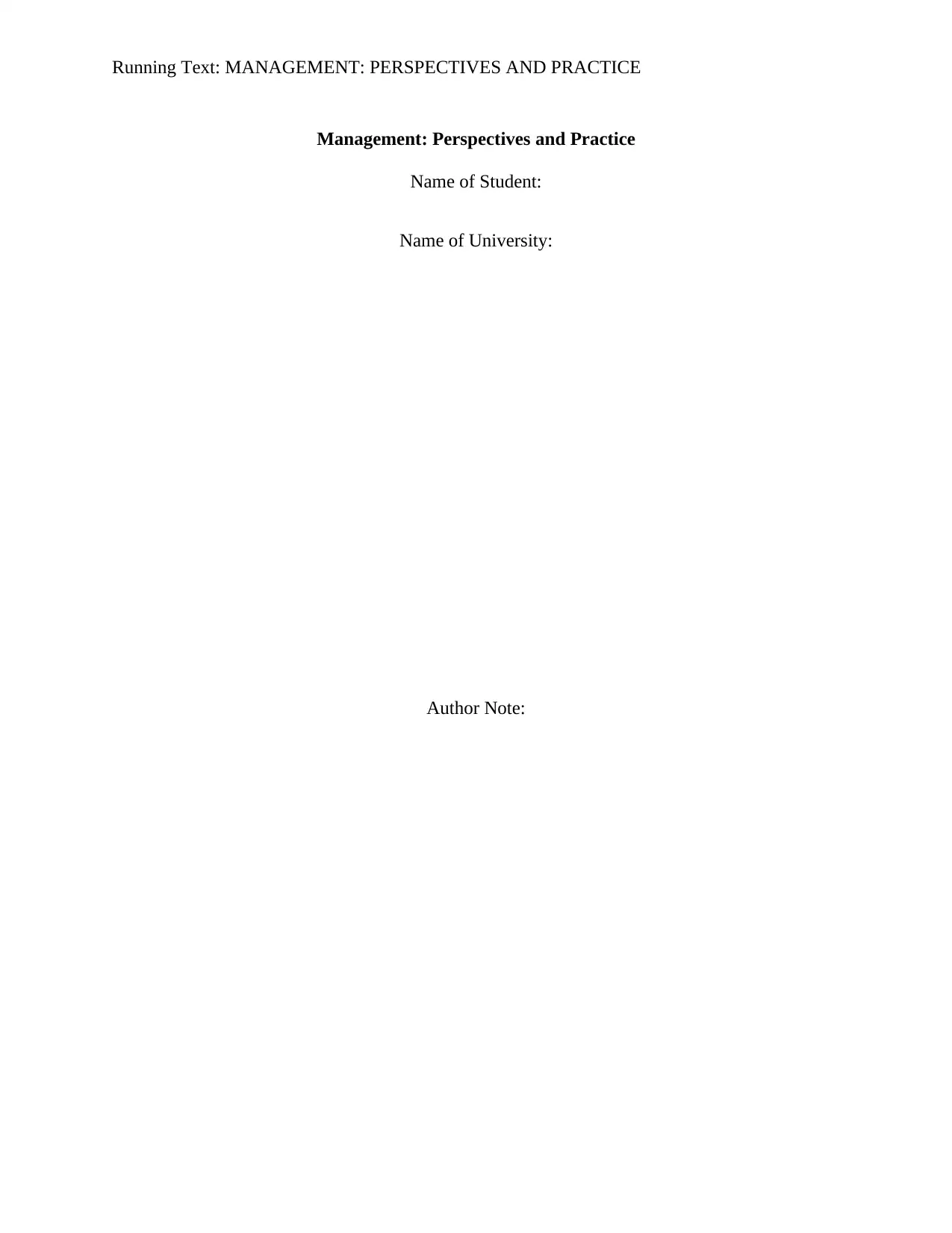
Running Text: MANAGEMENT: PERSPECTIVES AND PRACTICE
Management: Perspectives and Practice
Name of Student:
Name of University:
Author Note:
Management: Perspectives and Practice
Name of Student:
Name of University:
Author Note:
Paraphrase This Document
Need a fresh take? Get an instant paraphrase of this document with our AI Paraphraser
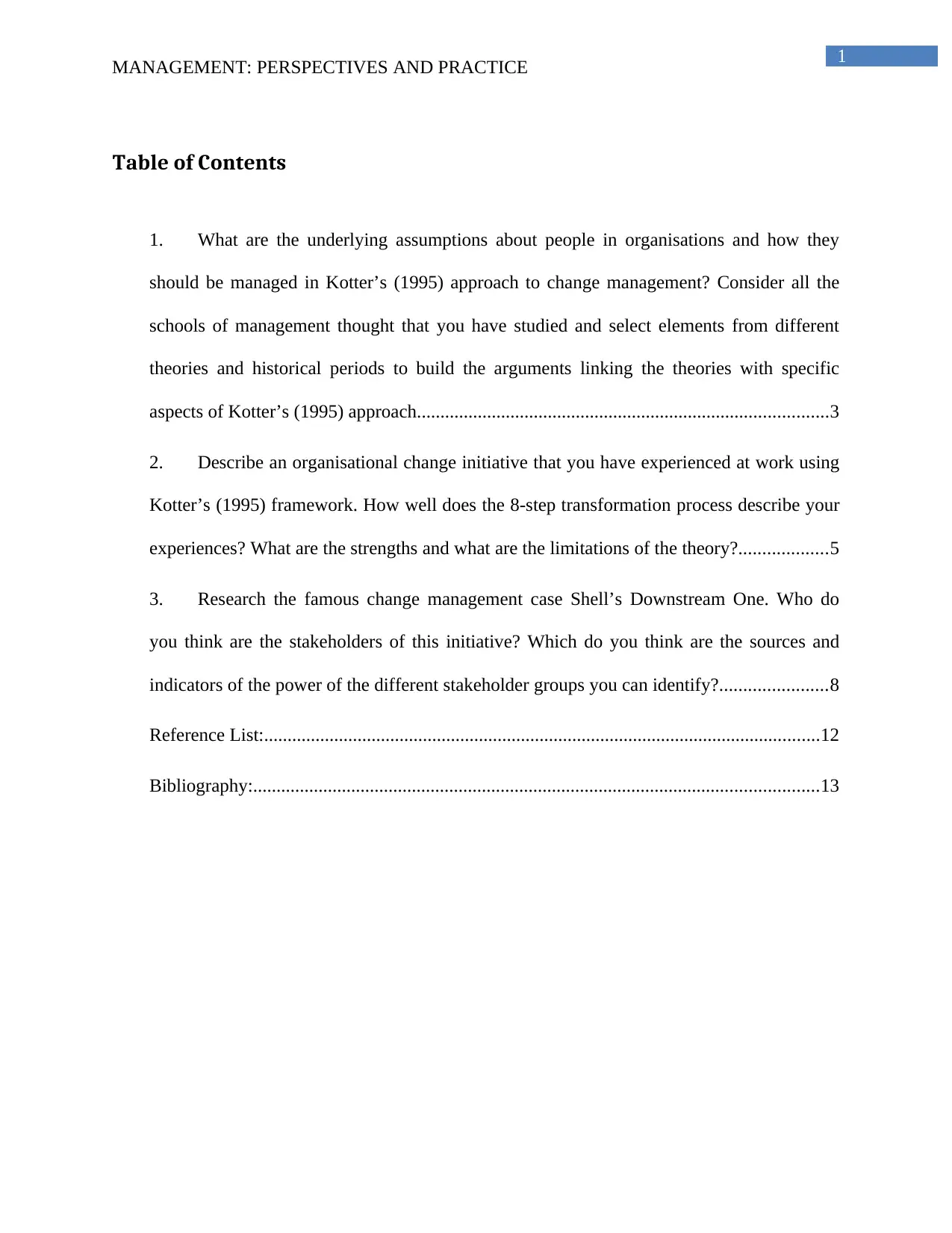
1
MANAGEMENT: PERSPECTIVES AND PRACTICE
Table of Contents
1. What are the underlying assumptions about people in organisations and how they
should be managed in Kotter’s (1995) approach to change management? Consider all the
schools of management thought that you have studied and select elements from different
theories and historical periods to build the arguments linking the theories with specific
aspects of Kotter’s (1995) approach........................................................................................3
2. Describe an organisational change initiative that you have experienced at work using
Kotter’s (1995) framework. How well does the 8-step transformation process describe your
experiences? What are the strengths and what are the limitations of the theory?...................5
3. Research the famous change management case Shell’s Downstream One. Who do
you think are the stakeholders of this initiative? Which do you think are the sources and
indicators of the power of the different stakeholder groups you can identify?.......................8
Reference List:.......................................................................................................................12
Bibliography:.........................................................................................................................13
MANAGEMENT: PERSPECTIVES AND PRACTICE
Table of Contents
1. What are the underlying assumptions about people in organisations and how they
should be managed in Kotter’s (1995) approach to change management? Consider all the
schools of management thought that you have studied and select elements from different
theories and historical periods to build the arguments linking the theories with specific
aspects of Kotter’s (1995) approach........................................................................................3
2. Describe an organisational change initiative that you have experienced at work using
Kotter’s (1995) framework. How well does the 8-step transformation process describe your
experiences? What are the strengths and what are the limitations of the theory?...................5
3. Research the famous change management case Shell’s Downstream One. Who do
you think are the stakeholders of this initiative? Which do you think are the sources and
indicators of the power of the different stakeholder groups you can identify?.......................8
Reference List:.......................................................................................................................12
Bibliography:.........................................................................................................................13
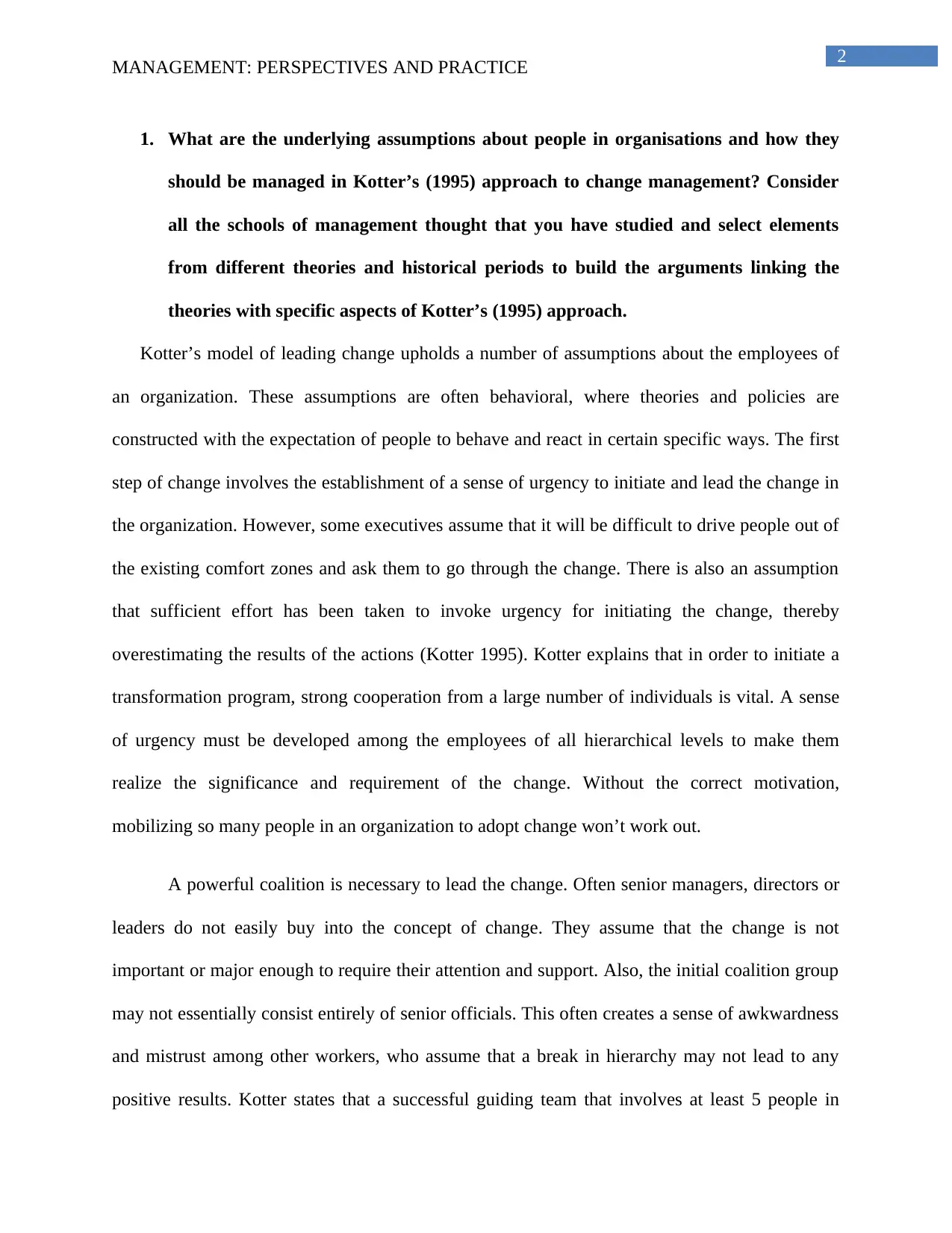
2
MANAGEMENT: PERSPECTIVES AND PRACTICE
1. What are the underlying assumptions about people in organisations and how they
should be managed in Kotter’s (1995) approach to change management? Consider
all the schools of management thought that you have studied and select elements
from different theories and historical periods to build the arguments linking the
theories with specific aspects of Kotter’s (1995) approach.
Kotter’s model of leading change upholds a number of assumptions about the employees of
an organization. These assumptions are often behavioral, where theories and policies are
constructed with the expectation of people to behave and react in certain specific ways. The first
step of change involves the establishment of a sense of urgency to initiate and lead the change in
the organization. However, some executives assume that it will be difficult to drive people out of
the existing comfort zones and ask them to go through the change. There is also an assumption
that sufficient effort has been taken to invoke urgency for initiating the change, thereby
overestimating the results of the actions (Kotter 1995). Kotter explains that in order to initiate a
transformation program, strong cooperation from a large number of individuals is vital. A sense
of urgency must be developed among the employees of all hierarchical levels to make them
realize the significance and requirement of the change. Without the correct motivation,
mobilizing so many people in an organization to adopt change won’t work out.
A powerful coalition is necessary to lead the change. Often senior managers, directors or
leaders do not easily buy into the concept of change. They assume that the change is not
important or major enough to require their attention and support. Also, the initial coalition group
may not essentially consist entirely of senior officials. This often creates a sense of awkwardness
and mistrust among other workers, who assume that a break in hierarchy may not lead to any
positive results. Kotter states that a successful guiding team that involves at least 5 people in
MANAGEMENT: PERSPECTIVES AND PRACTICE
1. What are the underlying assumptions about people in organisations and how they
should be managed in Kotter’s (1995) approach to change management? Consider
all the schools of management thought that you have studied and select elements
from different theories and historical periods to build the arguments linking the
theories with specific aspects of Kotter’s (1995) approach.
Kotter’s model of leading change upholds a number of assumptions about the employees of
an organization. These assumptions are often behavioral, where theories and policies are
constructed with the expectation of people to behave and react in certain specific ways. The first
step of change involves the establishment of a sense of urgency to initiate and lead the change in
the organization. However, some executives assume that it will be difficult to drive people out of
the existing comfort zones and ask them to go through the change. There is also an assumption
that sufficient effort has been taken to invoke urgency for initiating the change, thereby
overestimating the results of the actions (Kotter 1995). Kotter explains that in order to initiate a
transformation program, strong cooperation from a large number of individuals is vital. A sense
of urgency must be developed among the employees of all hierarchical levels to make them
realize the significance and requirement of the change. Without the correct motivation,
mobilizing so many people in an organization to adopt change won’t work out.
A powerful coalition is necessary to lead the change. Often senior managers, directors or
leaders do not easily buy into the concept of change. They assume that the change is not
important or major enough to require their attention and support. Also, the initial coalition group
may not essentially consist entirely of senior officials. This often creates a sense of awkwardness
and mistrust among other workers, who assume that a break in hierarchy may not lead to any
positive results. Kotter states that a successful guiding team that involves at least 5 people in
⊘ This is a preview!⊘
Do you want full access?
Subscribe today to unlock all pages.

Trusted by 1+ million students worldwide
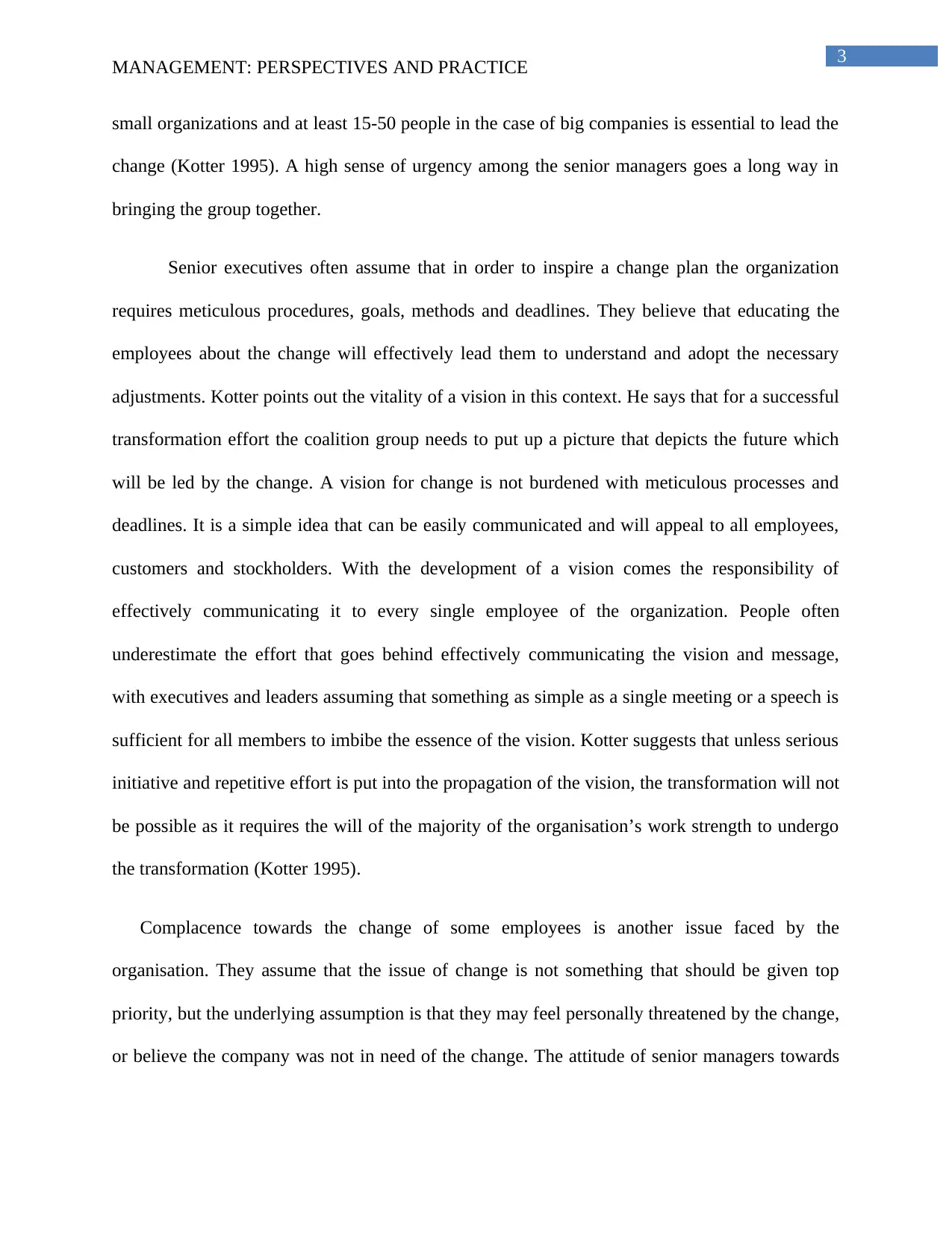
3
MANAGEMENT: PERSPECTIVES AND PRACTICE
small organizations and at least 15-50 people in the case of big companies is essential to lead the
change (Kotter 1995). A high sense of urgency among the senior managers goes a long way in
bringing the group together.
Senior executives often assume that in order to inspire a change plan the organization
requires meticulous procedures, goals, methods and deadlines. They believe that educating the
employees about the change will effectively lead them to understand and adopt the necessary
adjustments. Kotter points out the vitality of a vision in this context. He says that for a successful
transformation effort the coalition group needs to put up a picture that depicts the future which
will be led by the change. A vision for change is not burdened with meticulous processes and
deadlines. It is a simple idea that can be easily communicated and will appeal to all employees,
customers and stockholders. With the development of a vision comes the responsibility of
effectively communicating it to every single employee of the organization. People often
underestimate the effort that goes behind effectively communicating the vision and message,
with executives and leaders assuming that something as simple as a single meeting or a speech is
sufficient for all members to imbibe the essence of the vision. Kotter suggests that unless serious
initiative and repetitive effort is put into the propagation of the vision, the transformation will not
be possible as it requires the will of the majority of the organisation’s work strength to undergo
the transformation (Kotter 1995).
Complacence towards the change of some employees is another issue faced by the
organisation. They assume that the issue of change is not something that should be given top
priority, but the underlying assumption is that they may feel personally threatened by the change,
or believe the company was not in need of the change. The attitude of senior managers towards
MANAGEMENT: PERSPECTIVES AND PRACTICE
small organizations and at least 15-50 people in the case of big companies is essential to lead the
change (Kotter 1995). A high sense of urgency among the senior managers goes a long way in
bringing the group together.
Senior executives often assume that in order to inspire a change plan the organization
requires meticulous procedures, goals, methods and deadlines. They believe that educating the
employees about the change will effectively lead them to understand and adopt the necessary
adjustments. Kotter points out the vitality of a vision in this context. He says that for a successful
transformation effort the coalition group needs to put up a picture that depicts the future which
will be led by the change. A vision for change is not burdened with meticulous processes and
deadlines. It is a simple idea that can be easily communicated and will appeal to all employees,
customers and stockholders. With the development of a vision comes the responsibility of
effectively communicating it to every single employee of the organization. People often
underestimate the effort that goes behind effectively communicating the vision and message,
with executives and leaders assuming that something as simple as a single meeting or a speech is
sufficient for all members to imbibe the essence of the vision. Kotter suggests that unless serious
initiative and repetitive effort is put into the propagation of the vision, the transformation will not
be possible as it requires the will of the majority of the organisation’s work strength to undergo
the transformation (Kotter 1995).
Complacence towards the change of some employees is another issue faced by the
organisation. They assume that the issue of change is not something that should be given top
priority, but the underlying assumption is that they may feel personally threatened by the change,
or believe the company was not in need of the change. The attitude of senior managers towards
Paraphrase This Document
Need a fresh take? Get an instant paraphrase of this document with our AI Paraphraser
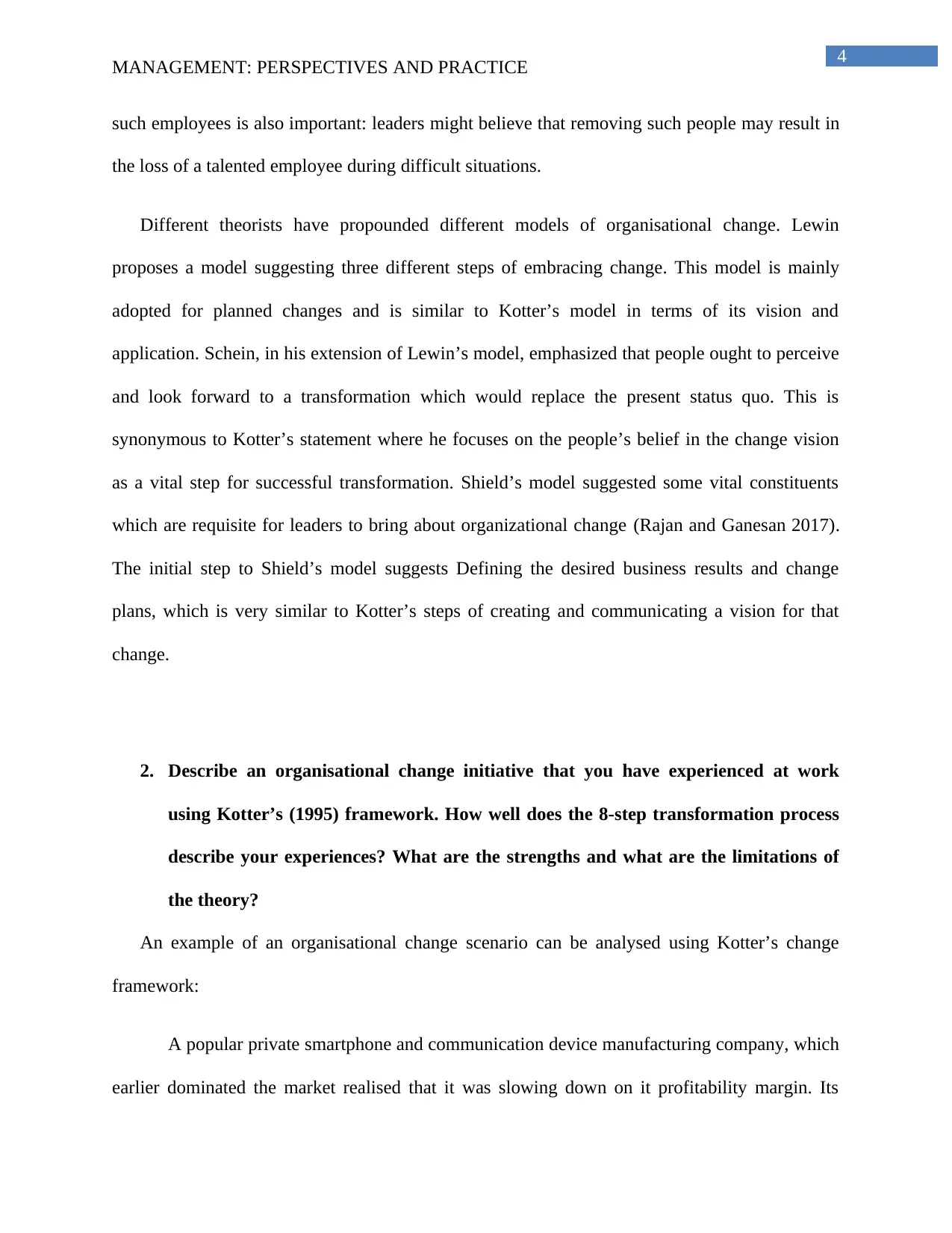
4
MANAGEMENT: PERSPECTIVES AND PRACTICE
such employees is also important: leaders might believe that removing such people may result in
the loss of a talented employee during difficult situations.
Different theorists have propounded different models of organisational change. Lewin
proposes a model suggesting three different steps of embracing change. This model is mainly
adopted for planned changes and is similar to Kotter’s model in terms of its vision and
application. Schein, in his extension of Lewin’s model, emphasized that people ought to perceive
and look forward to a transformation which would replace the present status quo. This is
synonymous to Kotter’s statement where he focuses on the people’s belief in the change vision
as a vital step for successful transformation. Shield’s model suggested some vital constituents
which are requisite for leaders to bring about organizational change (Rajan and Ganesan 2017).
The initial step to Shield’s model suggests Defining the desired business results and change
plans, which is very similar to Kotter’s steps of creating and communicating a vision for that
change.
2. Describe an organisational change initiative that you have experienced at work
using Kotter’s (1995) framework. How well does the 8-step transformation process
describe your experiences? What are the strengths and what are the limitations of
the theory?
An example of an organisational change scenario can be analysed using Kotter’s change
framework:
A popular private smartphone and communication device manufacturing company, which
earlier dominated the market realised that it was slowing down on it profitability margin. Its
MANAGEMENT: PERSPECTIVES AND PRACTICE
such employees is also important: leaders might believe that removing such people may result in
the loss of a talented employee during difficult situations.
Different theorists have propounded different models of organisational change. Lewin
proposes a model suggesting three different steps of embracing change. This model is mainly
adopted for planned changes and is similar to Kotter’s model in terms of its vision and
application. Schein, in his extension of Lewin’s model, emphasized that people ought to perceive
and look forward to a transformation which would replace the present status quo. This is
synonymous to Kotter’s statement where he focuses on the people’s belief in the change vision
as a vital step for successful transformation. Shield’s model suggested some vital constituents
which are requisite for leaders to bring about organizational change (Rajan and Ganesan 2017).
The initial step to Shield’s model suggests Defining the desired business results and change
plans, which is very similar to Kotter’s steps of creating and communicating a vision for that
change.
2. Describe an organisational change initiative that you have experienced at work
using Kotter’s (1995) framework. How well does the 8-step transformation process
describe your experiences? What are the strengths and what are the limitations of
the theory?
An example of an organisational change scenario can be analysed using Kotter’s change
framework:
A popular private smartphone and communication device manufacturing company, which
earlier dominated the market realised that it was slowing down on it profitability margin. Its
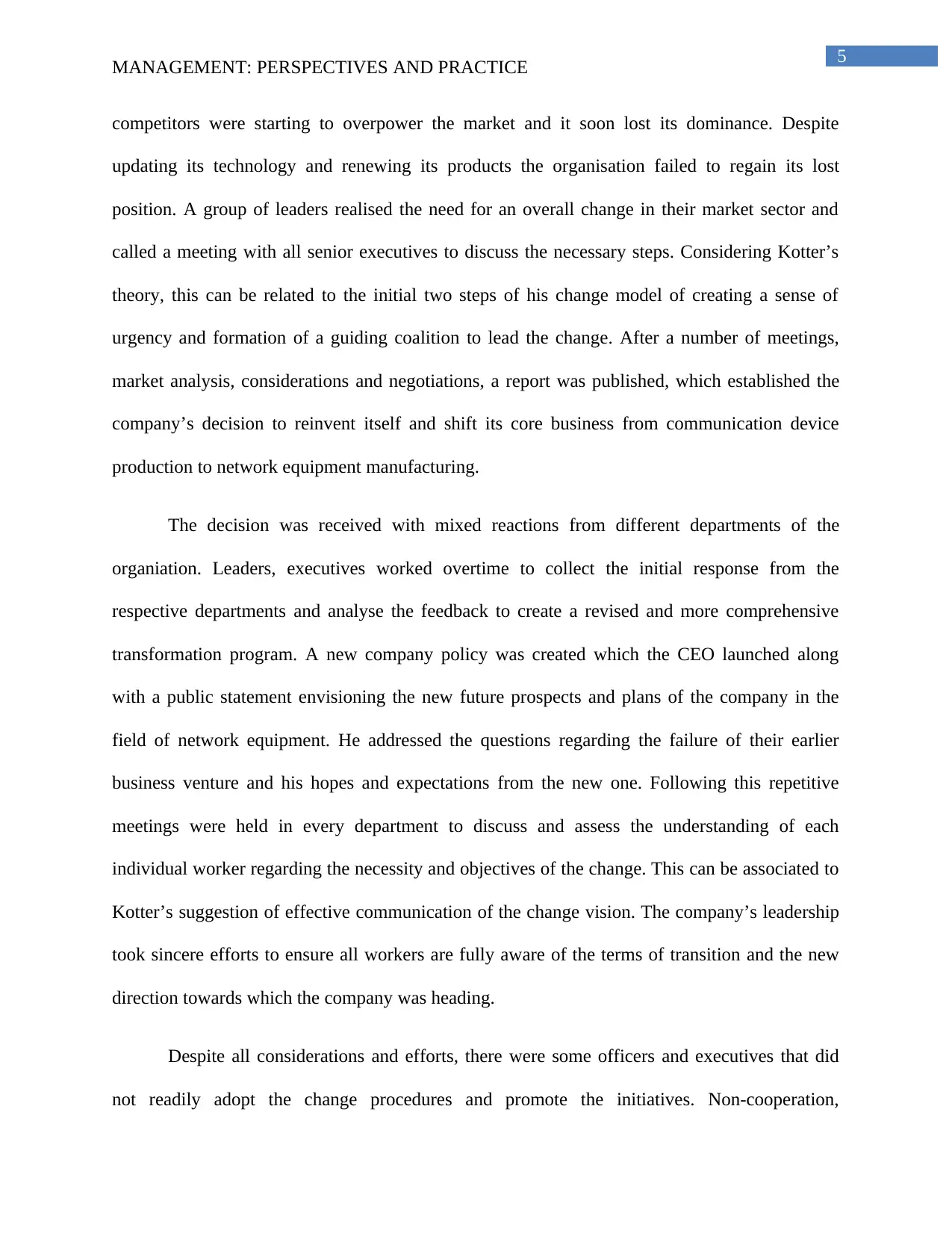
5
MANAGEMENT: PERSPECTIVES AND PRACTICE
competitors were starting to overpower the market and it soon lost its dominance. Despite
updating its technology and renewing its products the organisation failed to regain its lost
position. A group of leaders realised the need for an overall change in their market sector and
called a meeting with all senior executives to discuss the necessary steps. Considering Kotter’s
theory, this can be related to the initial two steps of his change model of creating a sense of
urgency and formation of a guiding coalition to lead the change. After a number of meetings,
market analysis, considerations and negotiations, a report was published, which established the
company’s decision to reinvent itself and shift its core business from communication device
production to network equipment manufacturing.
The decision was received with mixed reactions from different departments of the
organiation. Leaders, executives worked overtime to collect the initial response from the
respective departments and analyse the feedback to create a revised and more comprehensive
transformation program. A new company policy was created which the CEO launched along
with a public statement envisioning the new future prospects and plans of the company in the
field of network equipment. He addressed the questions regarding the failure of their earlier
business venture and his hopes and expectations from the new one. Following this repetitive
meetings were held in every department to discuss and assess the understanding of each
individual worker regarding the necessity and objectives of the change. This can be associated to
Kotter’s suggestion of effective communication of the change vision. The company’s leadership
took sincere efforts to ensure all workers are fully aware of the terms of transition and the new
direction towards which the company was heading.
Despite all considerations and efforts, there were some officers and executives that did
not readily adopt the change procedures and promote the initiatives. Non-cooperation,
MANAGEMENT: PERSPECTIVES AND PRACTICE
competitors were starting to overpower the market and it soon lost its dominance. Despite
updating its technology and renewing its products the organisation failed to regain its lost
position. A group of leaders realised the need for an overall change in their market sector and
called a meeting with all senior executives to discuss the necessary steps. Considering Kotter’s
theory, this can be related to the initial two steps of his change model of creating a sense of
urgency and formation of a guiding coalition to lead the change. After a number of meetings,
market analysis, considerations and negotiations, a report was published, which established the
company’s decision to reinvent itself and shift its core business from communication device
production to network equipment manufacturing.
The decision was received with mixed reactions from different departments of the
organiation. Leaders, executives worked overtime to collect the initial response from the
respective departments and analyse the feedback to create a revised and more comprehensive
transformation program. A new company policy was created which the CEO launched along
with a public statement envisioning the new future prospects and plans of the company in the
field of network equipment. He addressed the questions regarding the failure of their earlier
business venture and his hopes and expectations from the new one. Following this repetitive
meetings were held in every department to discuss and assess the understanding of each
individual worker regarding the necessity and objectives of the change. This can be associated to
Kotter’s suggestion of effective communication of the change vision. The company’s leadership
took sincere efforts to ensure all workers are fully aware of the terms of transition and the new
direction towards which the company was heading.
Despite all considerations and efforts, there were some officers and executives that did
not readily adopt the change procedures and promote the initiatives. Non-cooperation,
⊘ This is a preview!⊘
Do you want full access?
Subscribe today to unlock all pages.

Trusted by 1+ million students worldwide
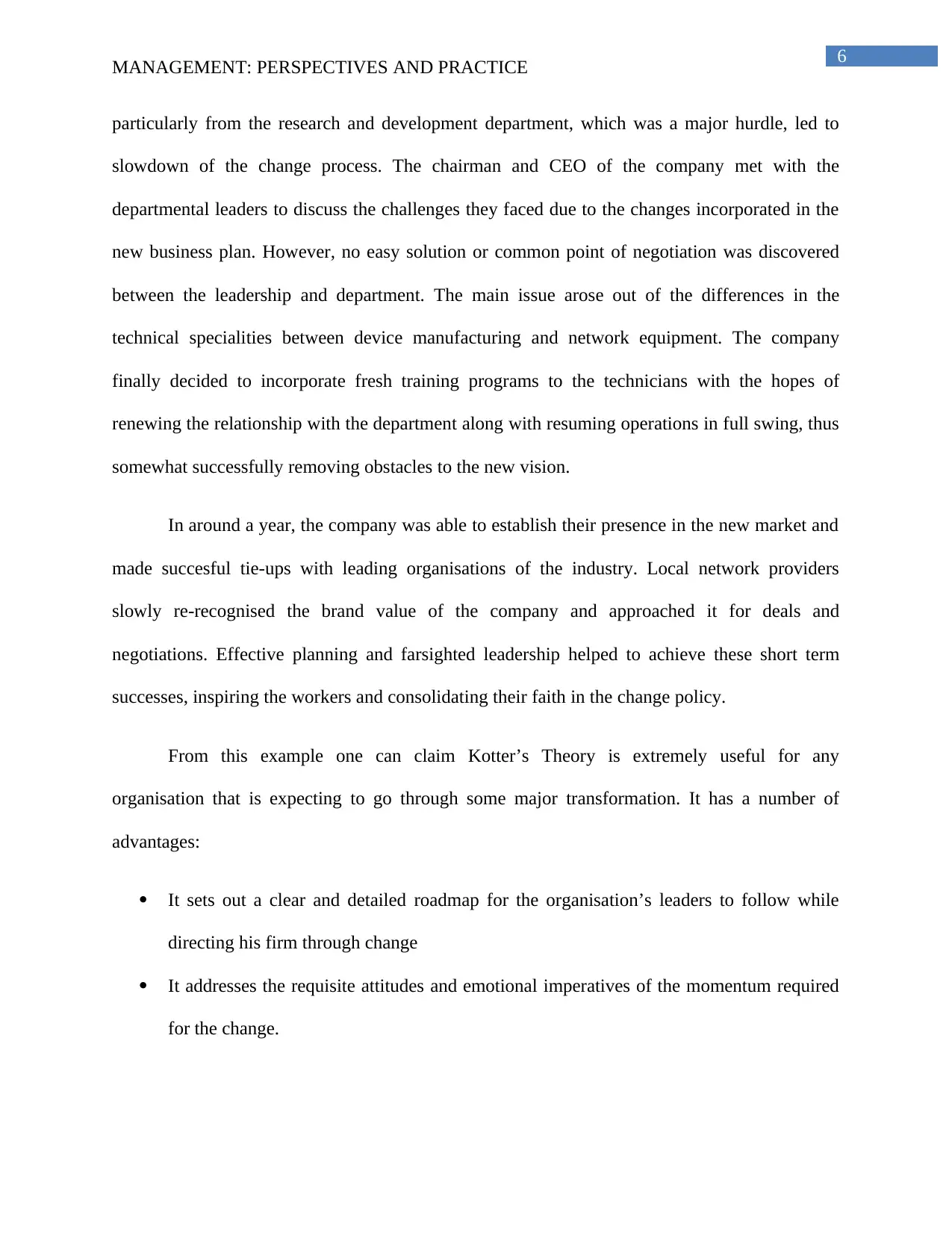
6
MANAGEMENT: PERSPECTIVES AND PRACTICE
particularly from the research and development department, which was a major hurdle, led to
slowdown of the change process. The chairman and CEO of the company met with the
departmental leaders to discuss the challenges they faced due to the changes incorporated in the
new business plan. However, no easy solution or common point of negotiation was discovered
between the leadership and department. The main issue arose out of the differences in the
technical specialities between device manufacturing and network equipment. The company
finally decided to incorporate fresh training programs to the technicians with the hopes of
renewing the relationship with the department along with resuming operations in full swing, thus
somewhat successfully removing obstacles to the new vision.
In around a year, the company was able to establish their presence in the new market and
made succesful tie-ups with leading organisations of the industry. Local network providers
slowly re-recognised the brand value of the company and approached it for deals and
negotiations. Effective planning and farsighted leadership helped to achieve these short term
successes, inspiring the workers and consolidating their faith in the change policy.
From this example one can claim Kotter’s Theory is extremely useful for any
organisation that is expecting to go through some major transformation. It has a number of
advantages:
It sets out a clear and detailed roadmap for the organisation’s leaders to follow while
directing his firm through change
It addresses the requisite attitudes and emotional imperatives of the momentum required
for the change.
MANAGEMENT: PERSPECTIVES AND PRACTICE
particularly from the research and development department, which was a major hurdle, led to
slowdown of the change process. The chairman and CEO of the company met with the
departmental leaders to discuss the challenges they faced due to the changes incorporated in the
new business plan. However, no easy solution or common point of negotiation was discovered
between the leadership and department. The main issue arose out of the differences in the
technical specialities between device manufacturing and network equipment. The company
finally decided to incorporate fresh training programs to the technicians with the hopes of
renewing the relationship with the department along with resuming operations in full swing, thus
somewhat successfully removing obstacles to the new vision.
In around a year, the company was able to establish their presence in the new market and
made succesful tie-ups with leading organisations of the industry. Local network providers
slowly re-recognised the brand value of the company and approached it for deals and
negotiations. Effective planning and farsighted leadership helped to achieve these short term
successes, inspiring the workers and consolidating their faith in the change policy.
From this example one can claim Kotter’s Theory is extremely useful for any
organisation that is expecting to go through some major transformation. It has a number of
advantages:
It sets out a clear and detailed roadmap for the organisation’s leaders to follow while
directing his firm through change
It addresses the requisite attitudes and emotional imperatives of the momentum required
for the change.
Paraphrase This Document
Need a fresh take? Get an instant paraphrase of this document with our AI Paraphraser
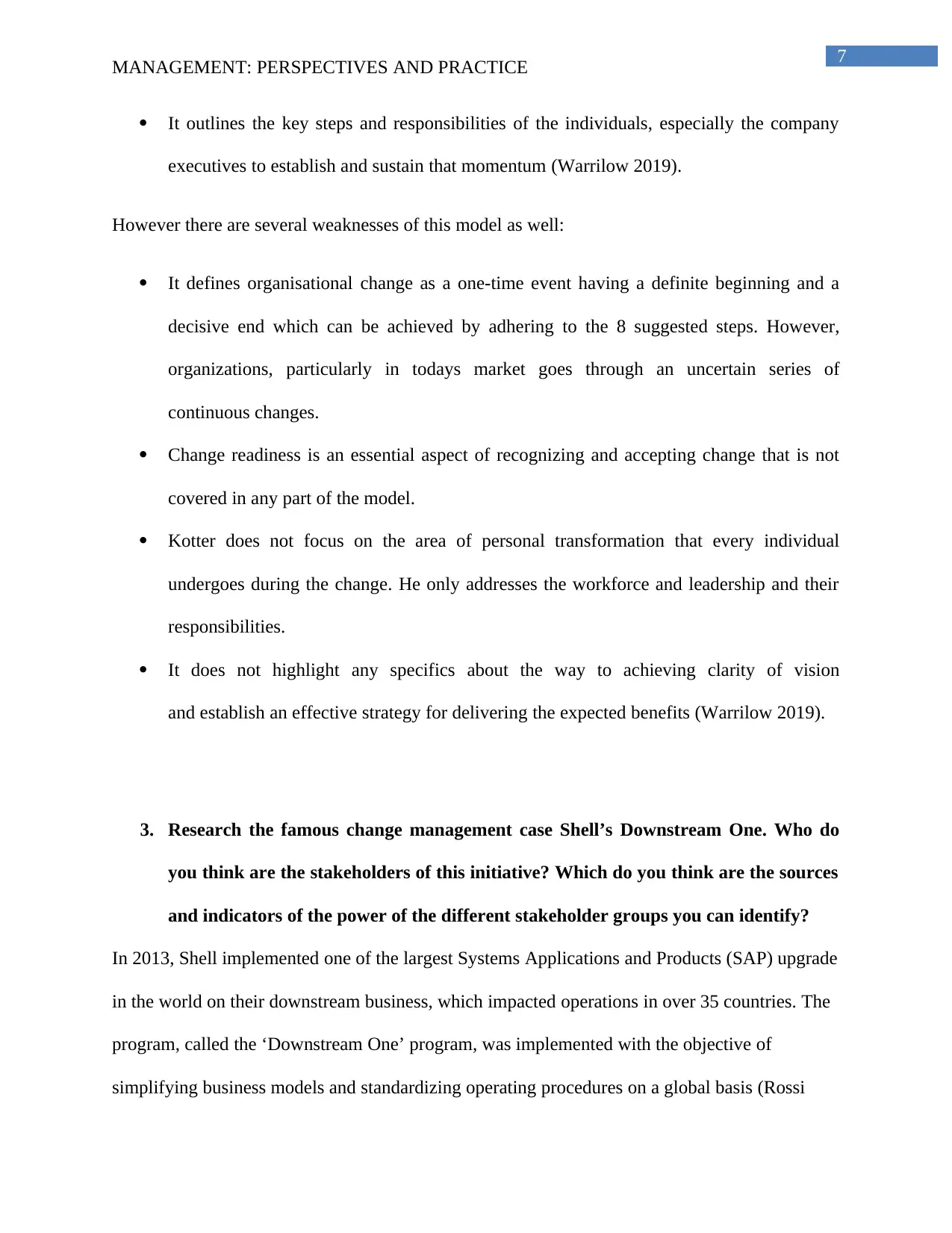
7
MANAGEMENT: PERSPECTIVES AND PRACTICE
It outlines the key steps and responsibilities of the individuals, especially the company
executives to establish and sustain that momentum (Warrilow 2019).
However there are several weaknesses of this model as well:
It defines organisational change as a one-time event having a definite beginning and a
decisive end which can be achieved by adhering to the 8 suggested steps. However,
organizations, particularly in todays market goes through an uncertain series of
continuous changes.
Change readiness is an essential aspect of recognizing and accepting change that is not
covered in any part of the model.
Kotter does not focus on the area of personal transformation that every individual
undergoes during the change. He only addresses the workforce and leadership and their
responsibilities.
It does not highlight any specifics about the way to achieving clarity of vision
and establish an effective strategy for delivering the expected benefits (Warrilow 2019).
3. Research the famous change management case Shell’s Downstream One. Who do
you think are the stakeholders of this initiative? Which do you think are the sources
and indicators of the power of the different stakeholder groups you can identify?
In 2013, Shell implemented one of the largest Systems Applications and Products (SAP) upgrade
in the world on their downstream business, which impacted operations in over 35 countries. The
program, called the ‘Downstream One’ program, was implemented with the objective of
simplifying business models and standardizing operating procedures on a global basis (Rossi
MANAGEMENT: PERSPECTIVES AND PRACTICE
It outlines the key steps and responsibilities of the individuals, especially the company
executives to establish and sustain that momentum (Warrilow 2019).
However there are several weaknesses of this model as well:
It defines organisational change as a one-time event having a definite beginning and a
decisive end which can be achieved by adhering to the 8 suggested steps. However,
organizations, particularly in todays market goes through an uncertain series of
continuous changes.
Change readiness is an essential aspect of recognizing and accepting change that is not
covered in any part of the model.
Kotter does not focus on the area of personal transformation that every individual
undergoes during the change. He only addresses the workforce and leadership and their
responsibilities.
It does not highlight any specifics about the way to achieving clarity of vision
and establish an effective strategy for delivering the expected benefits (Warrilow 2019).
3. Research the famous change management case Shell’s Downstream One. Who do
you think are the stakeholders of this initiative? Which do you think are the sources
and indicators of the power of the different stakeholder groups you can identify?
In 2013, Shell implemented one of the largest Systems Applications and Products (SAP) upgrade
in the world on their downstream business, which impacted operations in over 35 countries. The
program, called the ‘Downstream One’ program, was implemented with the objective of
simplifying business models and standardizing operating procedures on a global basis (Rossi
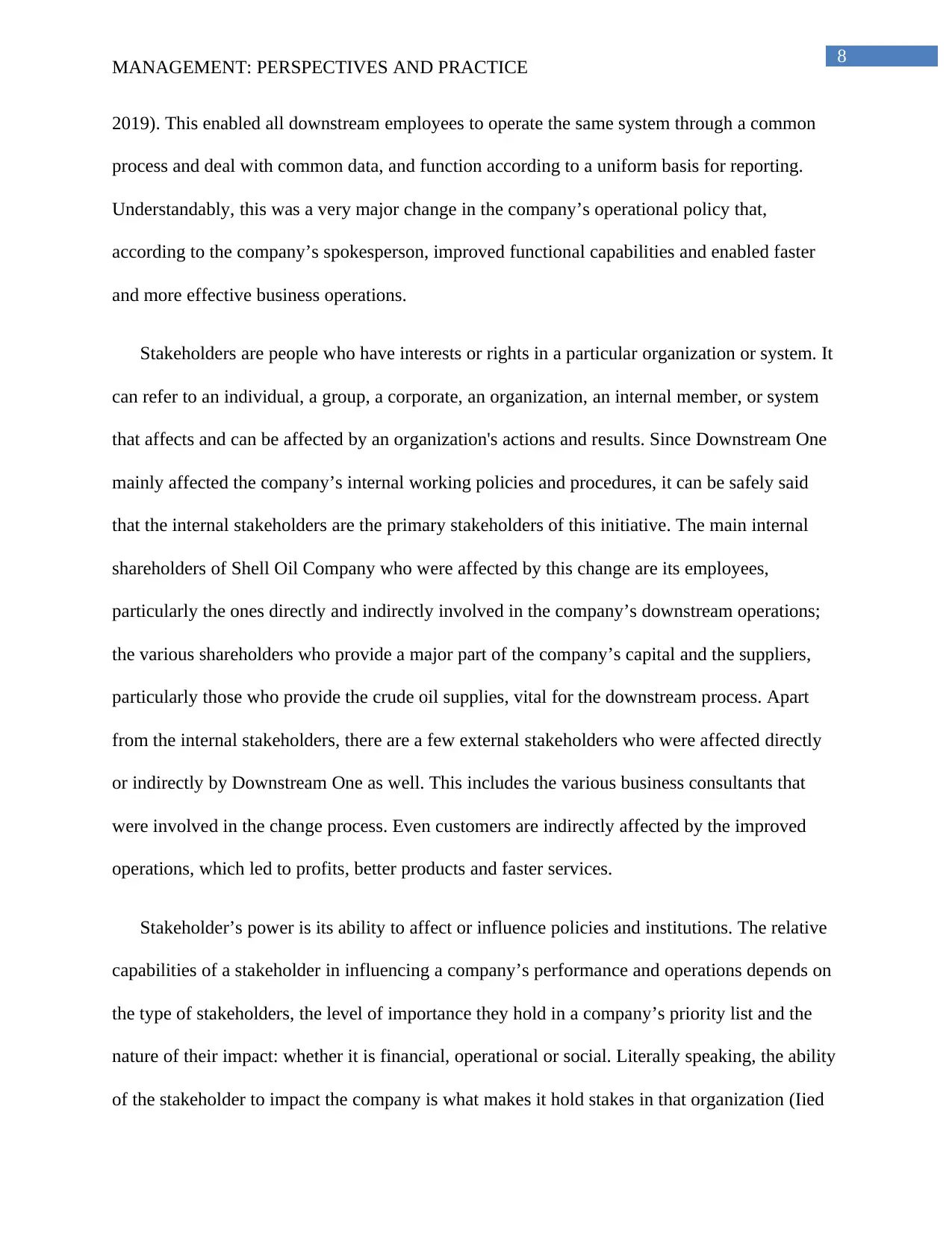
8
MANAGEMENT: PERSPECTIVES AND PRACTICE
2019). This enabled all downstream employees to operate the same system through a common
process and deal with common data, and function according to a uniform basis for reporting.
Understandably, this was a very major change in the company’s operational policy that,
according to the company’s spokesperson, improved functional capabilities and enabled faster
and more effective business operations.
Stakeholders are people who have interests or rights in a particular organization or system. It
can refer to an individual, a group, a corporate, an organization, an internal member, or system
that affects and can be affected by an organization's actions and results. Since Downstream One
mainly affected the company’s internal working policies and procedures, it can be safely said
that the internal stakeholders are the primary stakeholders of this initiative. The main internal
shareholders of Shell Oil Company who were affected by this change are its employees,
particularly the ones directly and indirectly involved in the company’s downstream operations;
the various shareholders who provide a major part of the company’s capital and the suppliers,
particularly those who provide the crude oil supplies, vital for the downstream process. Apart
from the internal stakeholders, there are a few external stakeholders who were affected directly
or indirectly by Downstream One as well. This includes the various business consultants that
were involved in the change process. Even customers are indirectly affected by the improved
operations, which led to profits, better products and faster services.
Stakeholder’s power is its ability to affect or influence policies and institutions. The relative
capabilities of a stakeholder in influencing a company’s performance and operations depends on
the type of stakeholders, the level of importance they hold in a company’s priority list and the
nature of their impact: whether it is financial, operational or social. Literally speaking, the ability
of the stakeholder to impact the company is what makes it hold stakes in that organization (Iied
MANAGEMENT: PERSPECTIVES AND PRACTICE
2019). This enabled all downstream employees to operate the same system through a common
process and deal with common data, and function according to a uniform basis for reporting.
Understandably, this was a very major change in the company’s operational policy that,
according to the company’s spokesperson, improved functional capabilities and enabled faster
and more effective business operations.
Stakeholders are people who have interests or rights in a particular organization or system. It
can refer to an individual, a group, a corporate, an organization, an internal member, or system
that affects and can be affected by an organization's actions and results. Since Downstream One
mainly affected the company’s internal working policies and procedures, it can be safely said
that the internal stakeholders are the primary stakeholders of this initiative. The main internal
shareholders of Shell Oil Company who were affected by this change are its employees,
particularly the ones directly and indirectly involved in the company’s downstream operations;
the various shareholders who provide a major part of the company’s capital and the suppliers,
particularly those who provide the crude oil supplies, vital for the downstream process. Apart
from the internal stakeholders, there are a few external stakeholders who were affected directly
or indirectly by Downstream One as well. This includes the various business consultants that
were involved in the change process. Even customers are indirectly affected by the improved
operations, which led to profits, better products and faster services.
Stakeholder’s power is its ability to affect or influence policies and institutions. The relative
capabilities of a stakeholder in influencing a company’s performance and operations depends on
the type of stakeholders, the level of importance they hold in a company’s priority list and the
nature of their impact: whether it is financial, operational or social. Literally speaking, the ability
of the stakeholder to impact the company is what makes it hold stakes in that organization (Iied
⊘ This is a preview!⊘
Do you want full access?
Subscribe today to unlock all pages.

Trusted by 1+ million students worldwide
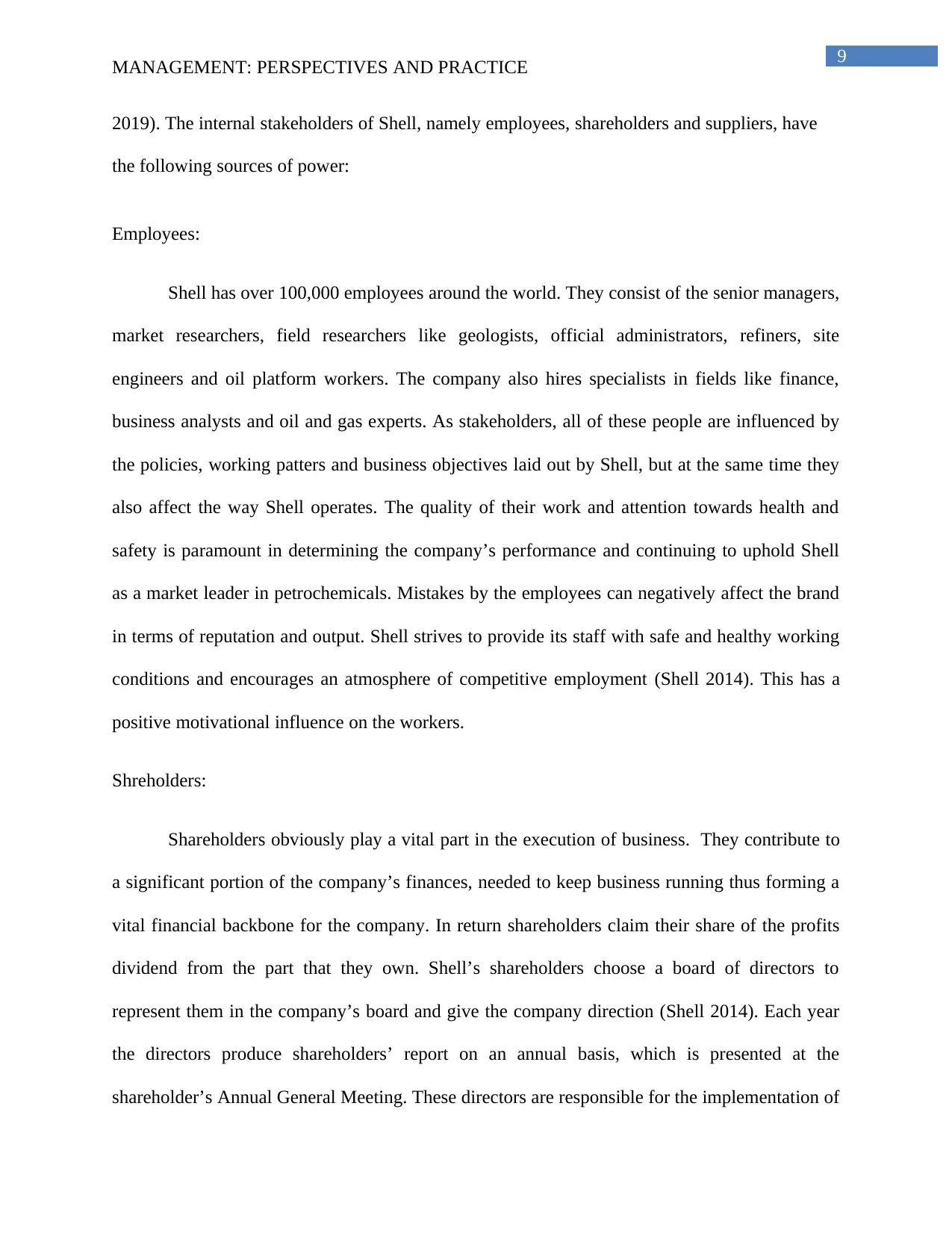
9
MANAGEMENT: PERSPECTIVES AND PRACTICE
2019). The internal stakeholders of Shell, namely employees, shareholders and suppliers, have
the following sources of power:
Employees:
Shell has over 100,000 employees around the world. They consist of the senior managers,
market researchers, field researchers like geologists, official administrators, refiners, site
engineers and oil platform workers. The company also hires specialists in fields like finance,
business analysts and oil and gas experts. As stakeholders, all of these people are influenced by
the policies, working patters and business objectives laid out by Shell, but at the same time they
also affect the way Shell operates. The quality of their work and attention towards health and
safety is paramount in determining the company’s performance and continuing to uphold Shell
as a market leader in petrochemicals. Mistakes by the employees can negatively affect the brand
in terms of reputation and output. Shell strives to provide its staff with safe and healthy working
conditions and encourages an atmosphere of competitive employment (Shell 2014). This has a
positive motivational influence on the workers.
Shreholders:
Shareholders obviously play a vital part in the execution of business. They contribute to
a significant portion of the company’s finances, needed to keep business running thus forming a
vital financial backbone for the company. In return shareholders claim their share of the profits
dividend from the part that they own. Shell’s shareholders choose a board of directors to
represent them in the company’s board and give the company direction (Shell 2014). Each year
the directors produce shareholders’ report on an annual basis, which is presented at the
shareholder’s Annual General Meeting. These directors are responsible for the implementation of
MANAGEMENT: PERSPECTIVES AND PRACTICE
2019). The internal stakeholders of Shell, namely employees, shareholders and suppliers, have
the following sources of power:
Employees:
Shell has over 100,000 employees around the world. They consist of the senior managers,
market researchers, field researchers like geologists, official administrators, refiners, site
engineers and oil platform workers. The company also hires specialists in fields like finance,
business analysts and oil and gas experts. As stakeholders, all of these people are influenced by
the policies, working patters and business objectives laid out by Shell, but at the same time they
also affect the way Shell operates. The quality of their work and attention towards health and
safety is paramount in determining the company’s performance and continuing to uphold Shell
as a market leader in petrochemicals. Mistakes by the employees can negatively affect the brand
in terms of reputation and output. Shell strives to provide its staff with safe and healthy working
conditions and encourages an atmosphere of competitive employment (Shell 2014). This has a
positive motivational influence on the workers.
Shreholders:
Shareholders obviously play a vital part in the execution of business. They contribute to
a significant portion of the company’s finances, needed to keep business running thus forming a
vital financial backbone for the company. In return shareholders claim their share of the profits
dividend from the part that they own. Shell’s shareholders choose a board of directors to
represent them in the company’s board and give the company direction (Shell 2014). Each year
the directors produce shareholders’ report on an annual basis, which is presented at the
shareholder’s Annual General Meeting. These directors are responsible for the implementation of
Paraphrase This Document
Need a fresh take? Get an instant paraphrase of this document with our AI Paraphraser
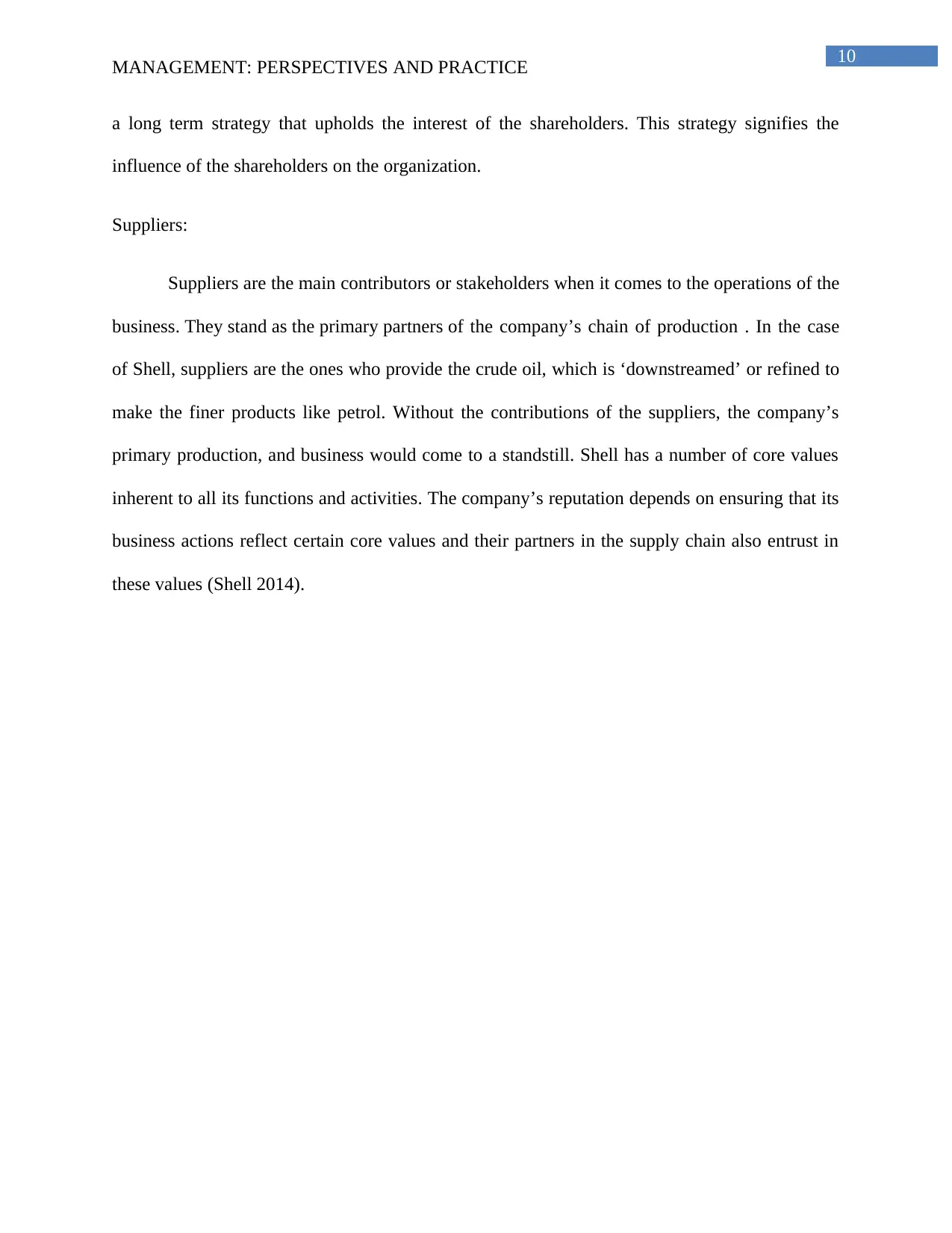
10
MANAGEMENT: PERSPECTIVES AND PRACTICE
a long term strategy that upholds the interest of the shareholders. This strategy signifies the
influence of the shareholders on the organization.
Suppliers:
Suppliers are the main contributors or stakeholders when it comes to the operations of the
business. They stand as the primary partners of the company’s chain of production . In the case
of Shell, suppliers are the ones who provide the crude oil, which is ‘downstreamed’ or refined to
make the finer products like petrol. Without the contributions of the suppliers, the company’s
primary production, and business would come to a standstill. Shell has a number of core values
inherent to all its functions and activities. The company’s reputation depends on ensuring that its
business actions reflect certain core values and their partners in the supply chain also entrust in
these values (Shell 2014).
MANAGEMENT: PERSPECTIVES AND PRACTICE
a long term strategy that upholds the interest of the shareholders. This strategy signifies the
influence of the shareholders on the organization.
Suppliers:
Suppliers are the main contributors or stakeholders when it comes to the operations of the
business. They stand as the primary partners of the company’s chain of production . In the case
of Shell, suppliers are the ones who provide the crude oil, which is ‘downstreamed’ or refined to
make the finer products like petrol. Without the contributions of the suppliers, the company’s
primary production, and business would come to a standstill. Shell has a number of core values
inherent to all its functions and activities. The company’s reputation depends on ensuring that its
business actions reflect certain core values and their partners in the supply chain also entrust in
these values (Shell 2014).
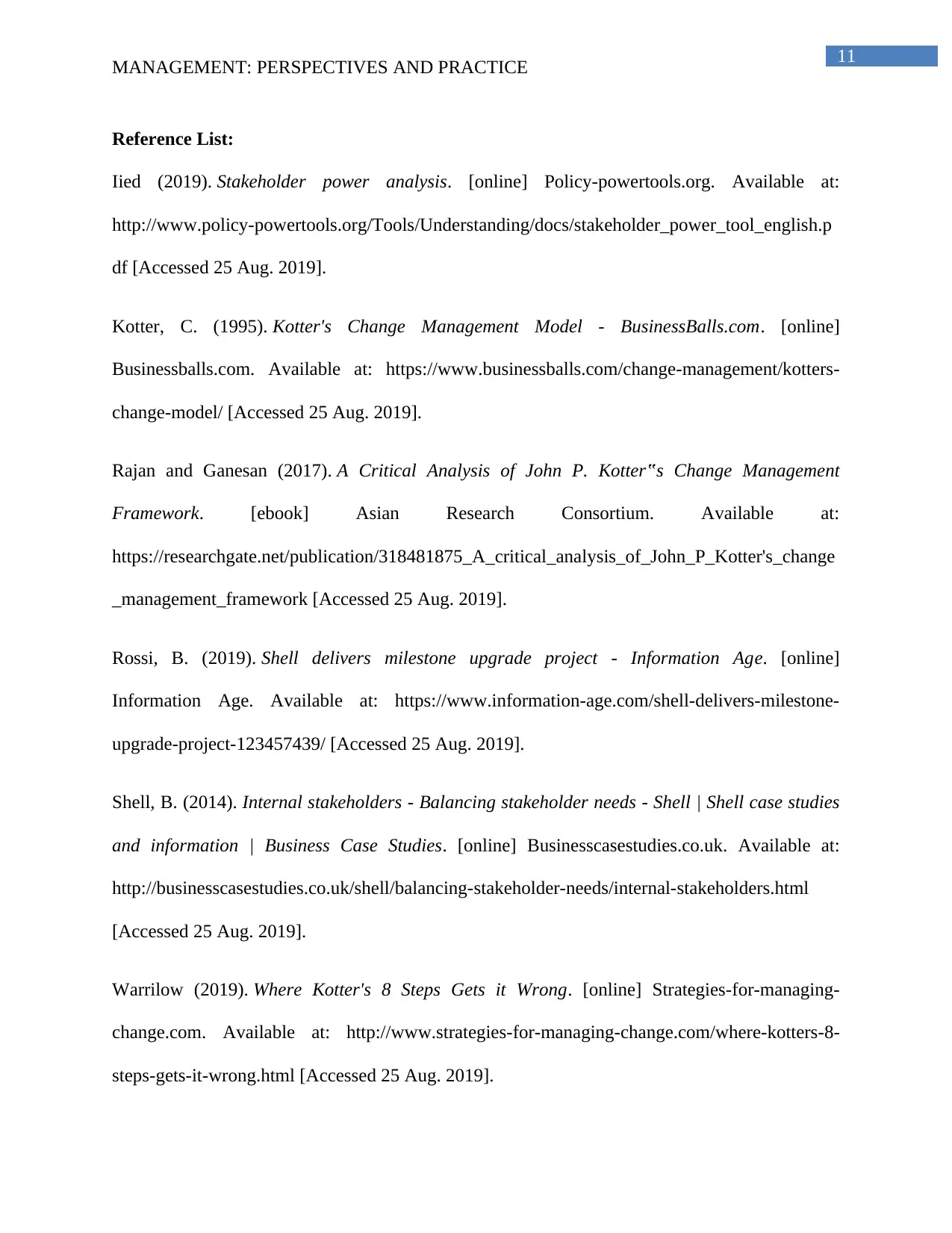
11
MANAGEMENT: PERSPECTIVES AND PRACTICE
Reference List:
Iied (2019). Stakeholder power analysis. [online] Policy-powertools.org. Available at:
http://www.policy-powertools.org/Tools/Understanding/docs/stakeholder_power_tool_english.p
df [Accessed 25 Aug. 2019].
Kotter, C. (1995). Kotter's Change Management Model - BusinessBalls.com. [online]
Businessballs.com. Available at: https://www.businessballs.com/change-management/kotters-
change-model/ [Accessed 25 Aug. 2019].
Rajan and Ganesan (2017). A Critical Analysis of John P. Kotter‟s Change Management
Framework. [ebook] Asian Research Consortium. Available at:
https://researchgate.net/publication/318481875_A_critical_analysis_of_John_P_Kotter's_change
_management_framework [Accessed 25 Aug. 2019].
Rossi, B. (2019). Shell delivers milestone upgrade project - Information Ag e. [online]
Information Age. Available at: https://www.information-age.com/shell-delivers-milestone-
upgrade-project-123457439/ [Accessed 25 Aug. 2019].
Shell, B. (2014). Internal stakeholders - Balancing stakeholder needs - Shell | Shell case studies
and information | Business Case Studies. [online] Businesscasestudies.co.uk. Available at:
http://businesscasestudies.co.uk/shell/balancing-stakeholder-needs/internal-stakeholders.html
[Accessed 25 Aug. 2019].
Warrilow (2019). Where Kotter's 8 Steps Gets it Wrong. [online] Strategies-for-managing-
change.com. Available at: http://www.strategies-for-managing-change.com/where-kotters-8-
steps-gets-it-wrong.html [Accessed 25 Aug. 2019].
MANAGEMENT: PERSPECTIVES AND PRACTICE
Reference List:
Iied (2019). Stakeholder power analysis. [online] Policy-powertools.org. Available at:
http://www.policy-powertools.org/Tools/Understanding/docs/stakeholder_power_tool_english.p
df [Accessed 25 Aug. 2019].
Kotter, C. (1995). Kotter's Change Management Model - BusinessBalls.com. [online]
Businessballs.com. Available at: https://www.businessballs.com/change-management/kotters-
change-model/ [Accessed 25 Aug. 2019].
Rajan and Ganesan (2017). A Critical Analysis of John P. Kotter‟s Change Management
Framework. [ebook] Asian Research Consortium. Available at:
https://researchgate.net/publication/318481875_A_critical_analysis_of_John_P_Kotter's_change
_management_framework [Accessed 25 Aug. 2019].
Rossi, B. (2019). Shell delivers milestone upgrade project - Information Ag e. [online]
Information Age. Available at: https://www.information-age.com/shell-delivers-milestone-
upgrade-project-123457439/ [Accessed 25 Aug. 2019].
Shell, B. (2014). Internal stakeholders - Balancing stakeholder needs - Shell | Shell case studies
and information | Business Case Studies. [online] Businesscasestudies.co.uk. Available at:
http://businesscasestudies.co.uk/shell/balancing-stakeholder-needs/internal-stakeholders.html
[Accessed 25 Aug. 2019].
Warrilow (2019). Where Kotter's 8 Steps Gets it Wrong. [online] Strategies-for-managing-
change.com. Available at: http://www.strategies-for-managing-change.com/where-kotters-8-
steps-gets-it-wrong.html [Accessed 25 Aug. 2019].
⊘ This is a preview!⊘
Do you want full access?
Subscribe today to unlock all pages.

Trusted by 1+ million students worldwide
1 out of 13
Related Documents
Your All-in-One AI-Powered Toolkit for Academic Success.
+13062052269
info@desklib.com
Available 24*7 on WhatsApp / Email
![[object Object]](/_next/static/media/star-bottom.7253800d.svg)
Unlock your academic potential
Copyright © 2020–2025 A2Z Services. All Rights Reserved. Developed and managed by ZUCOL.





